The Red Devil RX 480 8GB video card originally shipped from PowerColor nearly a month ago with a BIOS that limited the card’s potential to only a little bit faster than the reference RX 480. Although the card features an 8-pin power connector and a triple fan cooler that allows it to boost up to 1330MHz, when testing it this weekend, we found that it frequently throttled the clocks and its performance was disappointing. Yesterday, however, a brand new “unlocked” BIOS was released and this evaluation features the PowerColor Red Devil RX 480 running with the new BIOS versus the reference RX 480.
This 256KB unlocked BIOS file can be acquired from the PowerColor Devil Club or from TechPowerUp. The new unlocked BIOS is intended for enthusiasts who want to improve the Red Devil’s performance by increasing the card’s power limits, and it removes a TDP restriction in the original BIOS. Using this new BIOS will increase the power consumption, temperatures, and noise but it will bring performance gains. Since the Red Devil cards ship with a dual-BIOS and a switch, flashing the BIOS is easy and reasonably safe for the experienced overclocker.
AMD released its Polaris architecture as the RX 480 on June 29, and we compared the reference 8GB version to the GTX 980, to a mildly overclocked 970, and to the reference 290X and to the XFX 390 OC. We saw that even though it launched on immature drivers and with power issues, it is definitely well-suited for bringing less expensive VR to the masses as AMD claims. We followed its progress with improved drivers that somewhat addressed the power issues, and we also saw that it was only a fair overclocker versus the GTX 1060.
Now we have the PowerColor Red Devil RX 480 8GB with the new unlocked BIOS that we will benchmark at PowerColor clocks against the reference RX 480 with 25 games to see how it compares in performance. A follow up evaluation will manually overclock the Red Devil, and we will compare its performance with its competitor, the EVGA GTX 1060 SC, on Nvidia’s latest drivers.
The much smaller Red Devil RX 470 is pictured below next to the Red Devil RX 480 on the bottom. The aesthetics of red on black make for very good looking cards.
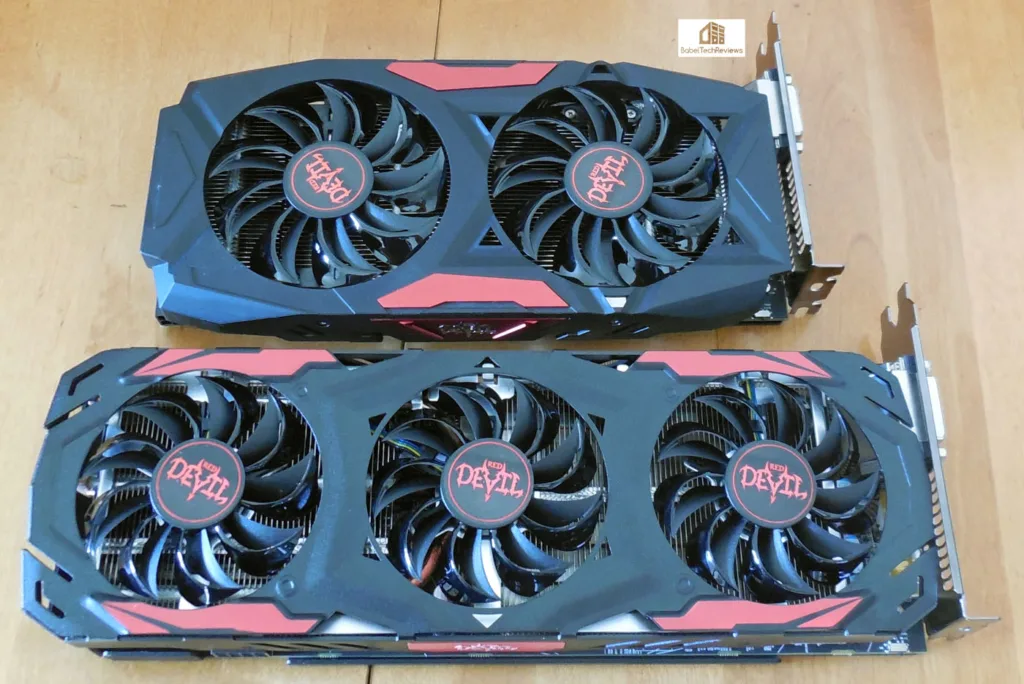 According to AMD, the RX 480 is differentiated from the RX 470 graphics card by the RX 480’s superior ability to deliver immersive VR experiences whereas the RX 470 is aimed primarily at desktop PC gaming. However, both the RX 480 and the RX 470 feature asynchronous shaders and new geometry capabilities that enable support for DirectX 12 and Vulkan with the latest version of Graphics Core Next (GCN) for PC gamers. And gamers will be able to stream and record their favorite games up to 4K at 60 FPS with virtually no performance impact.
According to AMD, the RX 480 is differentiated from the RX 470 graphics card by the RX 480’s superior ability to deliver immersive VR experiences whereas the RX 470 is aimed primarily at desktop PC gaming. However, both the RX 480 and the RX 470 feature asynchronous shaders and new geometry capabilities that enable support for DirectX 12 and Vulkan with the latest version of Graphics Core Next (GCN) for PC gamers. And gamers will be able to stream and record their favorite games up to 4K at 60 FPS with virtually no performance impact.
Polaris architecture combines the latest FinFET 14nm process technology and advanced power, gating, and clocking technologies to deliver a less power-hungry gaming experience compared with AMD’s last generation. Polaris boasts a brand new display engine and HDR-ready capabilities while the new Radeon WattMan offers a new level of customization and control over clocks, voltages, and temperature. And as with previous generations, Radeon software tends to optimize the hardware as drivers mature, improving gaming performance over time.
Instead of requiring 2 PCIe connectors as in the 28nm R9 200 and 300 series, the RX 480 and the Red Devil RX 470 get by with only 1, yet they deliver near R9 390X performance. In the case of the PowerColor Red Devil RX 480, it uses a single 8-pin PCIe cable versus the 6-pin power connector in the reference RX 470 and RX 480.
We saw the reference RX 480 get into trouble with its 6-pin connector as being insufficient for overclocking. In fact, we have to increase the fan speeds of the reference version to annoying noise levels just to prevent it from throttling its clocks. Having an 8-pin power connector plus superior 6+1 multi-phases where each phase supplies 25W instead of 22.5W found in the reference board, the Red Devil RX 480 is designed for superior performance, overclocking, and more stable power delivery.
Make sure to check the RX 480 8GB launch article which gives more details about Polaris’ new features.
The reference RX 480 8GB vs. the Red Devil RX 480 8GB
First, here are the specifications for the reference RX 480. Its core clock will boost from 1120MHz up to 1270MHz.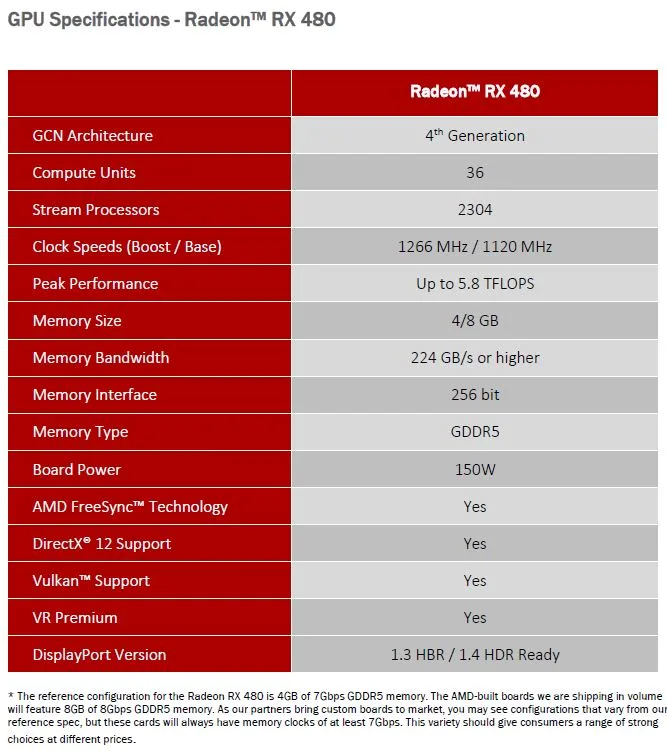
The above specifications are for the 8GB $239 version of RX 480 that we reviewed at launch. Below are the specifications for the $279 PowerColor Red Devil RX 480 that boosts its core clock up to 1330MHz, or potentially 60MHz higher than the reference version.
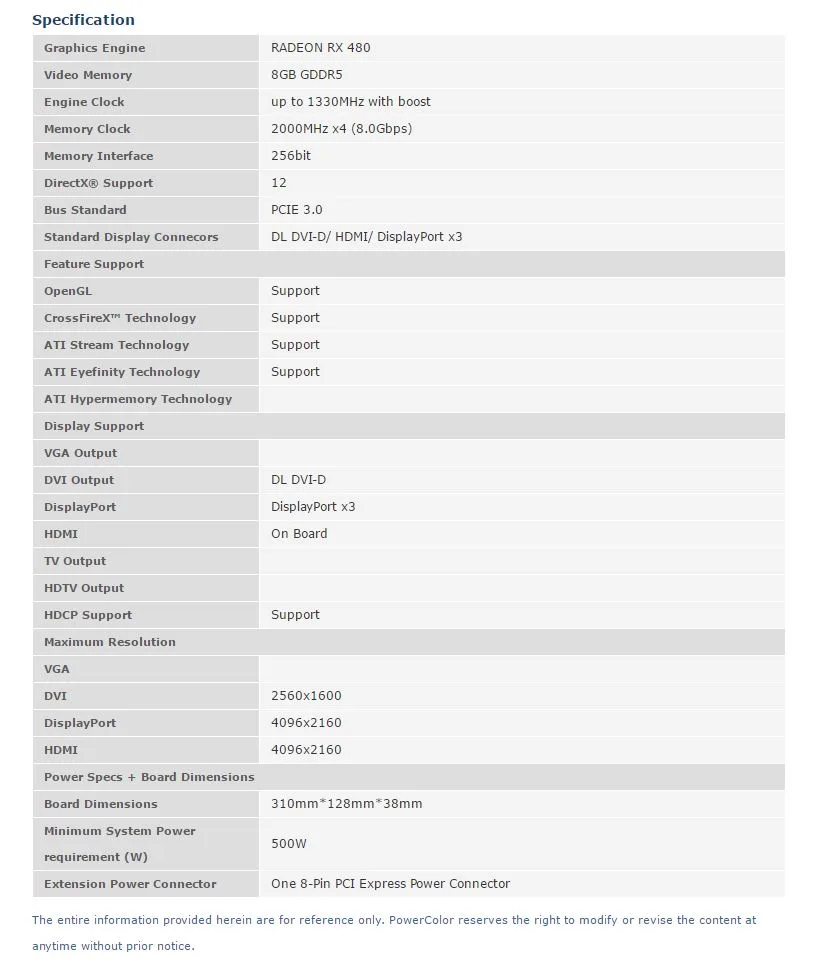
The specifications of the Red Devil RX 480 are quite impressive compared to the reference RX 480. The Red Devil’s boost clocks have been increased from 1270MHz to 1330MHz and its cooling and power delivery are greatly improved. This is why we were originally disappointed to see the rather conservative performance BIOS that PowerColor originally shipped with tended to throttle the clocks down to 1279MHz to keep it just barely ahead of the reference version. The quiet BIOS was no faster than the reference version, although it is certainly whisper-quiet.
Our Testbed
We are going to focus on just two cards in this evaluation, the reference RX 480 versus the Red Devil RX 480 with the unlocked BIOS. We will also show results of the reference RX 470 4GB and the Founders Edition of the GTX 1060. A follow up evaluation will compare the Red Devil RX 480 overclocked to its maximum versus the overclocked EVGA GTX 1060 SC on the latest Nvidia drivers.
We shall test 25 games and 2 synthetic benchmarks at 1920×1080 and at 2560×1440. Our testing platform is Windows 10 Home 64-bit, using an Intel Core i7-6700K at 4.00GHz which turbos to 4.4GHz for all cores as set in the ASRock Z7170 motherboard’s BIOS, and 16GB of G.SKILL DDR4 at 3000MHz.
- PowerColor Red Devil RX 480 8GB OC – $279 – at PowerColor clocks and with automatic fan speeds.
- RX 480 8GB – reference version – $239 to $259. The fan speed has been increased to keep the clocks from throttling.
- RX 470 4GB – reference version – $179
- GTX 1060 6GB – Founders Edition – $249
First, let’s take a closer look at the new PowerColor Red Devil RX 480.
A Closer Look at the PowerColor Red Devil RX 480
The Red Devil RX 480 8GB advertises itself as a premium card ready for both VR and gaming. Also, HDR ready, DX12 support, 14nm and FreeSync are emphasized on the front of the box.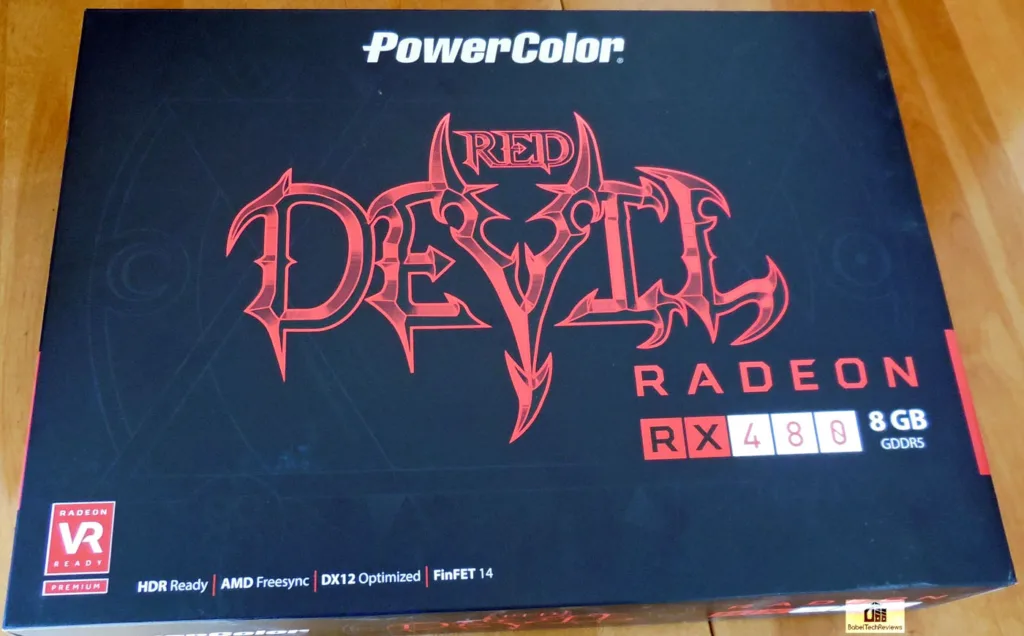
Here is the other side of the box showing the features as well as the power and system requirements.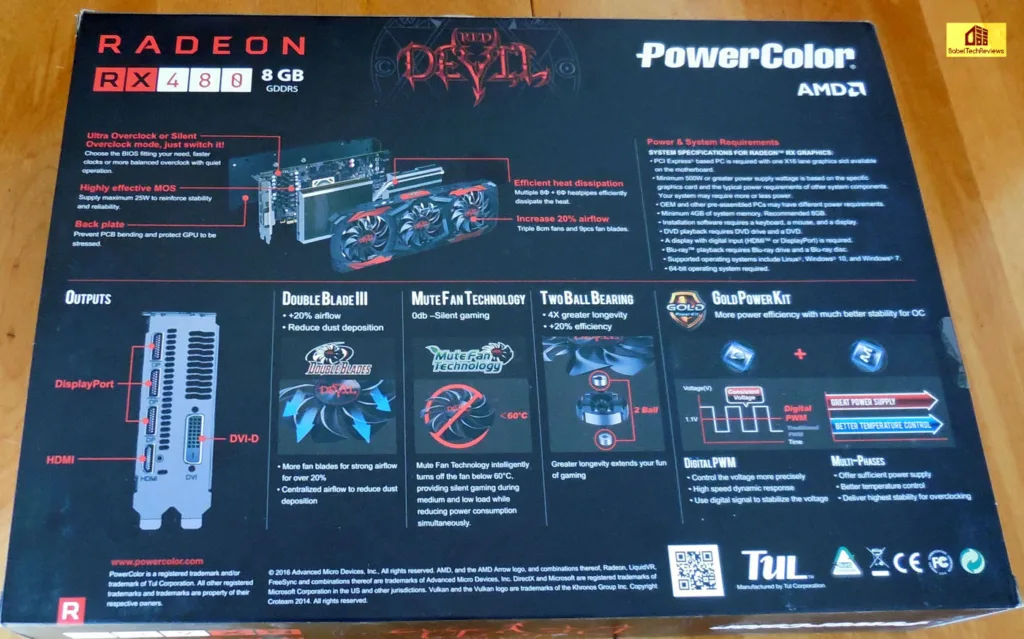 As illustrated on the box, there are two BIOS switches which can also really be useful if you have a bad flash. The default left side, Ultra Overclock, is for performance and the right side, Silent Overclock, is for quiet gaming.
As illustrated on the box, there are two BIOS switches which can also really be useful if you have a bad flash. The default left side, Ultra Overclock, is for performance and the right side, Silent Overclock, is for quiet gaming. 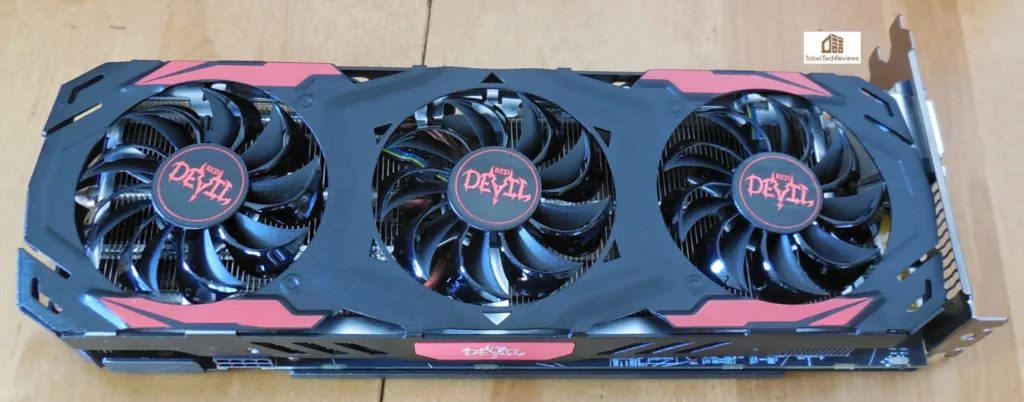
The PowerColor Red Devil RX 480 is a good looking and solidly built card with twin fan technology called Double Blade III which has more fan blades for increasing airflow and it prevents dust deposits. The Double Blade III is made with three 80mm 2-ball bearing fans to give what PowerColor claims is 4 times more longevity than regular fans. Looking through the fan blades, you can see a rather massive heatsink.
Turning it over, we see that it is has a solid backplate.
The PowerColor Red Devil card carries a hexagram inside a circle – a six-pointed star which is a symbol originating in Egypt and adopted as a symbol of the Jewish faith. Although PowerColor’s hexagram in a circle has nothing to do with the associated modern occult Pentagram symbol which is always a similarly drawn 5-pointed star inside a circle, it may well refer to the Seal of Solomon which implies that a Devil is bound within the card.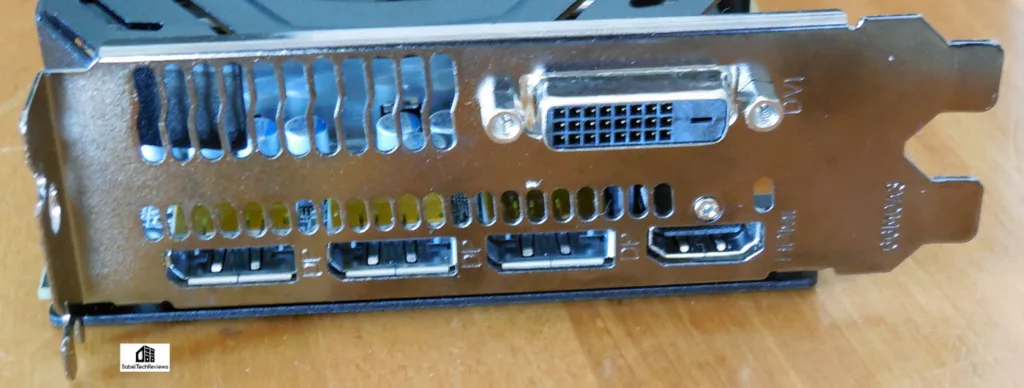
The Red Devil’s RX 470 connectors include 3 DisplayPorts and 1 HDMI connection and a Dual-Link DVI connector. The reference versions of both the RX 470 and RX 480 lack the DVI connector. Looking at the card the way it would set in your PC, the Red Devil logo is upside down.
The reference versions of the RX 470 and the RX 480 use only one 6-pin PCIe connector which got our reference RX 480 into trouble with power draw over the PCIe slot and also upset the stability of our PC when we tried to overclock it. On the other hand, PowerColor wisely uses an 8-pin power connector plus superior 6+1 multi-phases where each phase supplies 25W instead of 22.5W as in other cards for better stability and for better overclocking potential.
You can see the heatsink fins from the other side also.
Here is another view. The PowerColor Red Devil RX 480 is a good-looking card. Let’s check out its performance with its new unlocked BIOS versus the reference RX 480 after we look over our test configuration on the next page.
The PowerColor Red Devil RX 480 is a good-looking card. Let’s check out its performance with its new unlocked BIOS versus the reference RX 480 after we look over our test configuration on the next page.
Test Configuration – Hardware
- Intel Core i7-6700K (reference 4.0GHz, HyperThreading and Turbo boost is on to 4.4GHz; DX11 CPU graphics).
- ASRock Z7170M OC Formula motherboard (Intel Z7170 chipset, latest BIOS, PCIe 3.0/3.1 specification, CrossFire/SLI 8x+8x)
- G.Skill Ripjaws V 16GB DDR4 (2x8GB, dual channel at 3000MHz)
- PowerColor RX 480 8GB – $279 – at PowerColor RX 480 factory clocks with the “unlocked” BIOS, on loan from Tech of Tomorrow
- Diamond RX 480 8GB – $239(+) – reference version. The fan speed has been increased to prevent throttling.
- PowerColor Red Devil RX 470 4GB at RX 470 reference speeds, supplied by PowerColor
- GTX 1060 6GB Founders Edition at reference clocks, supplied by Nvidia
- 2TB Toshiba 7200 rpm HDD
- EVGA 1000G 1000W power supply unit
- Thermaltake Water2.0, supplied by Thermaltake
- Onboard Realtek Audio
- Genius SP-D150 speakers, supplied by Genius
- Thermaltake Overseer RX-I full tower case, supplied by Thermaltake
- ASUS 12X Blu-ray writer
- Monoprice Crystal Pro 4K
Test Configuration – Software
- AMD Crimson Software 16.8.2 used for the Red Devil RX 480 and 16.8.1 Hotfix drivers for the other AMD cards (the two sets of drivers are interchangeable and give the same performance results for our 25-game benchmark suite)
- Nvidia’s GeForce 368.64 (GTX 1060 launch) drivers. High Quality, prefer maximum performance, single display.
- VSync is off in the control panel.
- AA enabled as noted in games; all in-game settings are specified with 16xAF always applied
- All results show average frame rates including minimum frame rates shown in italics on the chart next to the averages in smaller font.
- Highest quality sound (stereo) used in all games.
- Windows 10 64-bit Home edition, all DX11 titles were run under DX11 render paths. Our four DX12 titles are run under the DX12 render path. Latest DirectX
- All games are patched to their latest versions at time of publication.
- Crimson Software’s WattMan was used for the RX 480/470. The Power Limit/Temperature targets are set to maximum for all cards. Fan speeds have been increased manually for the reference RX 480 to prevent throttling.
- Heaven 4.0 (Unigine)
The 25 PC Game benchmark suite & 2 synthetic tests
Synthetic
- Firestrike – Basic & Extreme
- Time Spy DX12
- Crysis 3
- Metro: Last Light Redux (2014)
- Middle Earth: Shadows of Mordor
- Alien Isolation
- Dragon’s Age: Inquisition
- Dying Light
- Grand Theft Auto V
- ProjectCARS
- the Witcher 3
- Batman: Arkham Origins
- Mad Max
- Fallout 4
- Star Wars Battlefront
- Assassin’s Creed Syndicate
- Just Cause 3
- Rainbow Six Siege
- DiRT Rally
- Far Cry Primal
- Tom Clancy’s The Division
- DOOM (*OpenGL)
- Mirror’s Edge Catalyst
DX12 Games
- Ashes of the Singularity
- Hitman
- Rise of the Tomb Raider
- Total War: Warhammer
AMD Settings
Here are the settings that we always use in AMD’s Crimson Control Center for our default benching. The new Power Efficiency Toggle is left off in our benching. 
Calculating Percentages
There are two methods of calculating percentages. One is the “Percentage Difference” that we used to compare the GTX 1080 versus the TITAN X, and the other is “Percentage Change” which we are using now to show the performance improvements of the factory-clocked PowerColor Red Devil RX 4870 over the reference RX 480 stock clocks.
For the percentage change, we mean the increase in frame rates between the reference RX 480 and the PowerColor factory clocks of the Red Devil RX 480, divided by the absolute value of the original stock frame rate in fps, multiplied by 100. We do this to show the PowerColor factory clocks with the unlocked BIOS over the stock RX 480 clocks.
The percentage change may be expressed by the algebraic formula where “V” is Value: ( ΔV / |V1| ) * 100 = ((V2 – V1) / |V1|) * 100
Let’s check out the shipping BIOS versus the “unlocked” BIOS next.
The Shipping BIOS vs. the “Unlocked” BIOS
PowerColor originally shipped the Red Devil RX 480 with a very conservative Performance BIOS that allowed it to boost to 1330MHz, but most of the time it throttled to 1279MHz which made it only slightly faster than the reference RX 480. Here is GPU-Z. The Pixel fill rate is 40.9 GPixels/s and the Texture Fillrate is 184.2 GTexels/s.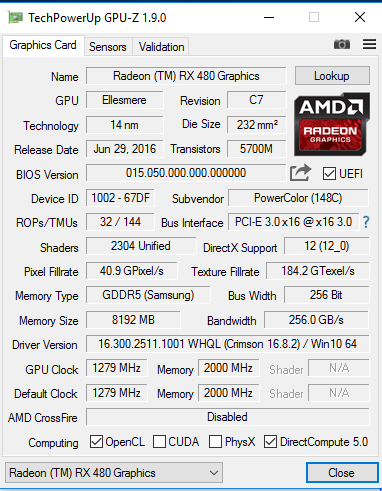
Here is the screenshot of the results of looping Heaven 4.0 continuously with the original BIOS at reference clocks.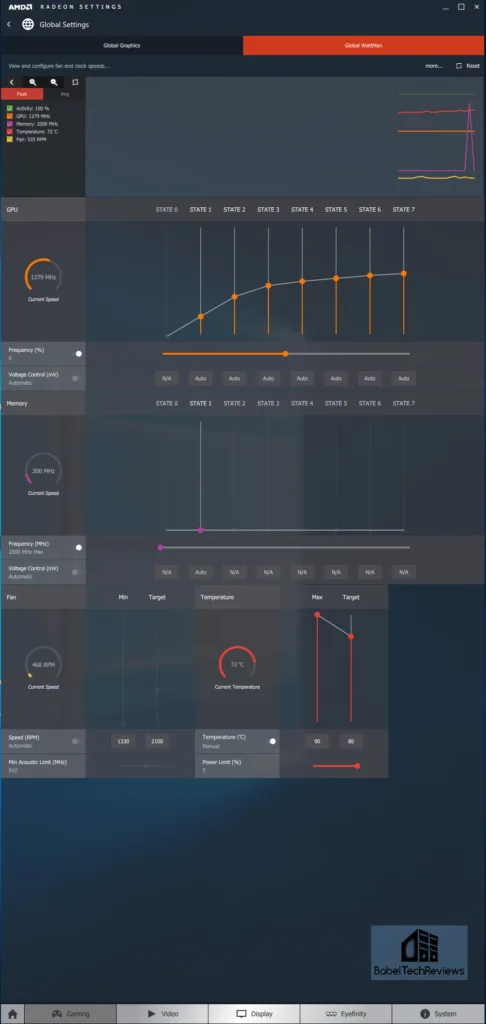
As you can see, the clocks stay around 1279MHz, well below the PowerColor Red Devil maximum boost of 1330MHz and just a few MHz over the maximum boost of the reference RX 480. Although the core occasionally boosts to the maximum of 1330MHz, ,it often throttles, and the temperature is kept to 72C with a very quiet fan profile. The Power Limit is restricted to +5% and our original overclocking results were poor.
Here is GlobalWattman with the new “unlocked” BIOS.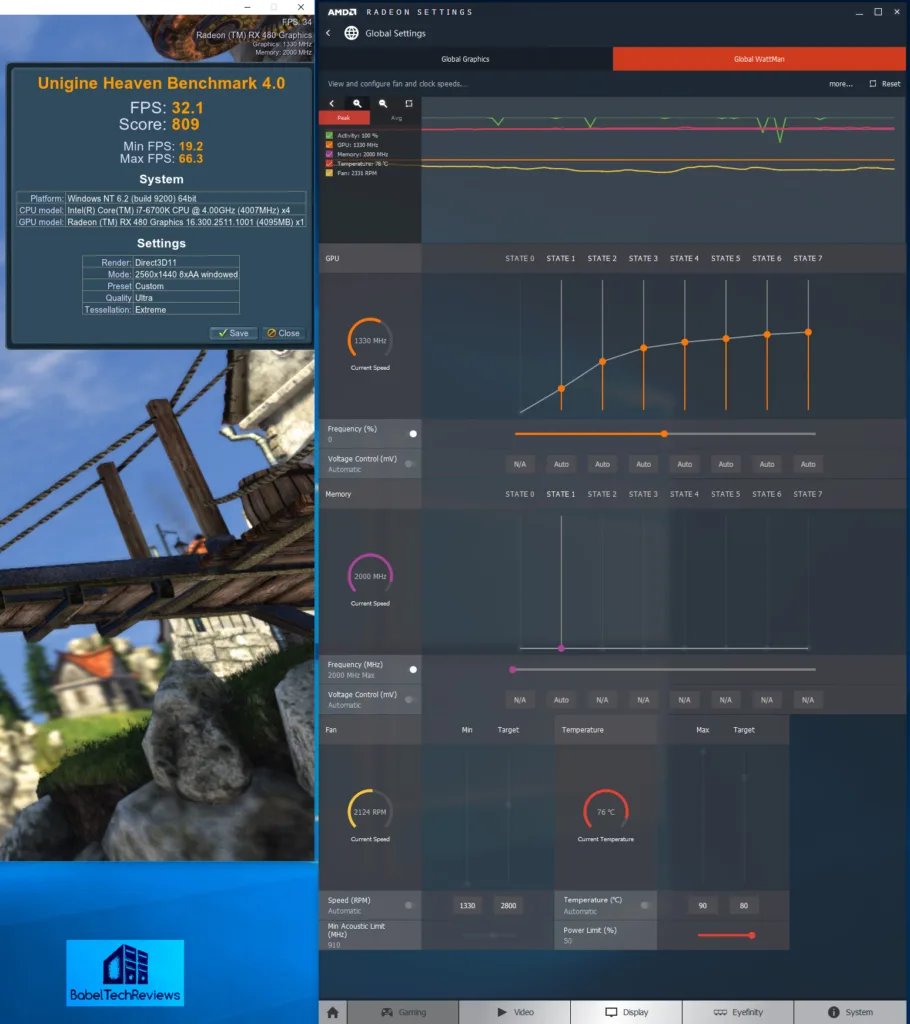
We see a significant change with the new unlocked BIOS. The clocks have now settled in at their maximum boost of 1330MHz – up from 1279MHz in the shipping BIOS – even after looping Heaven 4.0 for over 1/2 hour. And the Power Limit is now set to +50%, up over the original +5% and the temperature has gone up a few degrees. Although the fan speed is much higher, it is still reasonably quiet. In contrast, we have to turn up the fan speed of the reference RX 480 to keep it from throttling which brings its noise into the annoying range.
Even GPU-Z now shows a higher Pixel and Texture fill rate over the shipping BIOS. The Pixel fill rate is 42.6 GPixel/s, up over the original BIOS’ 40.9 GPixels/s, and the new Texture Fillrate is 191.5 GTexel/s, up from the original 184.2 GTexels/s.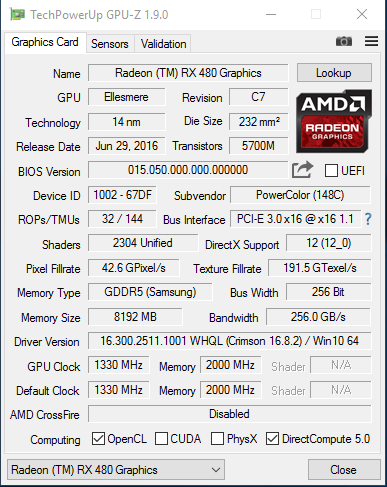
We did not attempt to overclock the Red Devil RX 480 yet. We are going to follow up next week to see how far we can overclock it with the new unlocked BIOS and we will also compare performance with the similarly-priced and overclocked EVGA GTX 1060 SC on the latest Nvidia drivers. Let’s head to the performance chart to see how the PowerColor Red Devil RX 480 now compares with the reference RX 480.
Performance summary charts & graphs
Here are our performance results of 25 games and 2 synthetic tests comparing the Red Devil RX 480 8GB at PowerColor factory clocks with the “unlocked” BIOS over the Diamond reference RX 480 8GB clocks which has its fan set manually to a higher speed to prevent throttling.
All results except for Firestrike and Time Spy are expressed in average fps (in Bold) and also generally in minimum fps (where they make sense, in smaller italics next to the averages). Each card is compared against the other in the adjoining results column at 1920×1080 and at 2560×1440 .
The first column represents the Red Devil RX 480 8GB at PowerColor factory clocks with the unlocked BIOS, the second column has the reference RX 480 8GB results, and the third column represents the percentage increase over the reference version.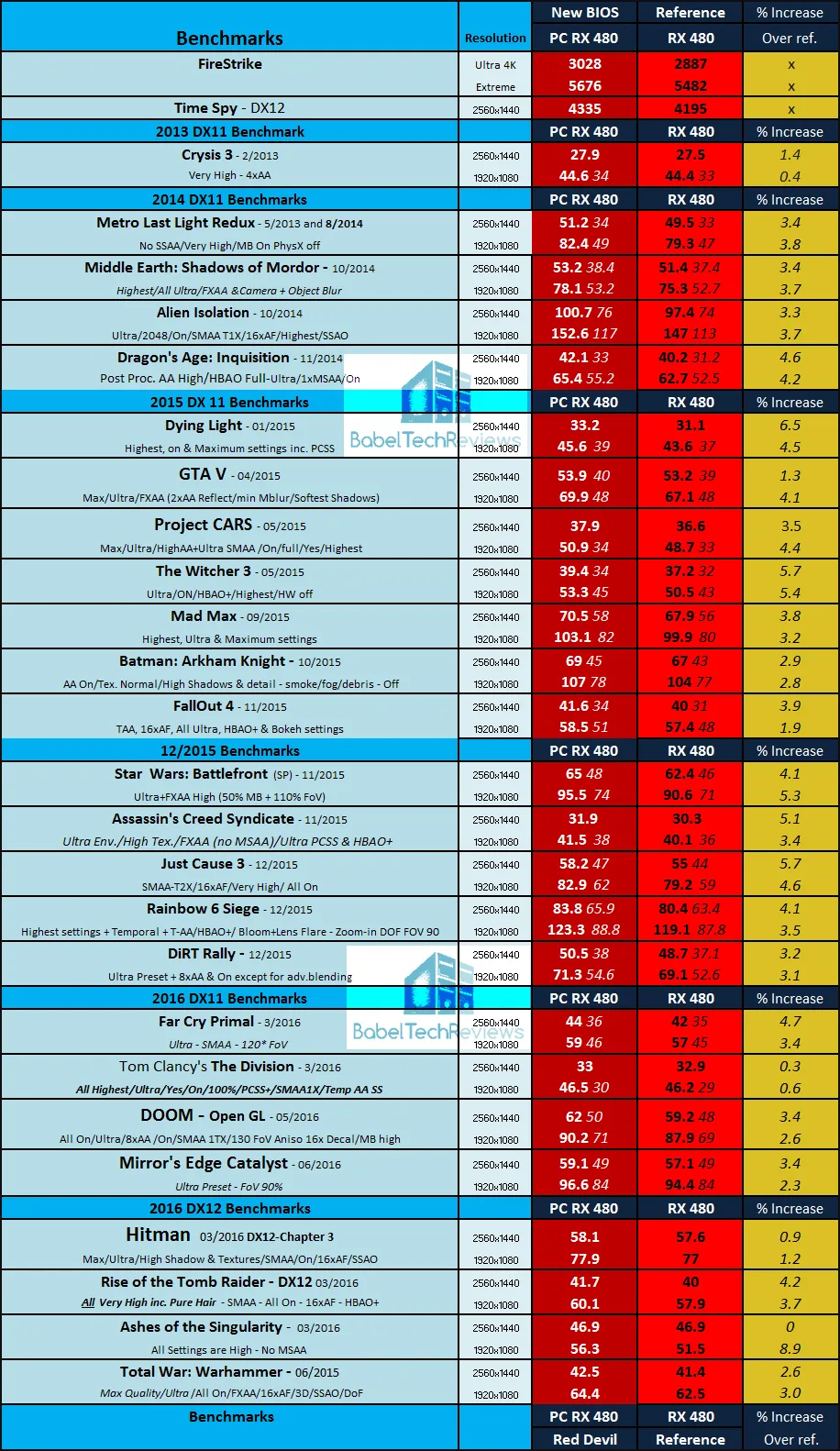
Generally we see a minimum of 3% increase over the reference clocks with the new BIOS which is significantly higher than the with the old BIOS that throttled back the clocks to nearly reference speeds. The Red Devil performance difference would be even higher if we did not increase the fan speed of the reference RX 480 to annoying levels to prevent its clocks from throttling.
Here is a larger test bed including the GTX 1060 Founder’s Edition and the Reference RX 470.
We see the PowerColor Red Devil RX 480 with its unlocked BIOS come closer to the performance of the Founders Edition of the GTX 1060, trading blows and winning a few more games than the reference version, and it also pulls away further from the RX 470 performance at stock clocks. We can’t wait to overclock it!
UPDATED 08/26/16. Check out Tech of Tomorrow‘s video using our benchmarks!
Let’s head for our conclusion.
The Conclusion
The Red Devil RX 480 improves in performance over the reference (non throttling) RX 480 with a simple BIOS flash by generally more than 3% to over 6%. The original PowerColor Red Devil shipping BIOS mostly throttled the clocks to slightly above reference non-throttling RX 480 clocks. It beats the RX 470 by a much wider margin now and becomes more competitive with the GTX 1060 than the reference RX 480. However, we will have to wait until next week to see just how close it comes to the stock and overclocked EVGA GTX 1060 SC when the Red Devil is overclocked further.
Let’s sum it up:
PowerColor Red Devil RX 480 Pros
- The PowerColor Red Devil RX 480 comes very close to GTX 1060 performance now compared with the reference RX 480 even though it was originally held back by its original shipping BIOS to near RX 480 maximum reference clocks, and it now beats the reference RX 470 rather handily.
- At $279 the Red Devil RX 480 is only $40 more than the reference RX 480, and it offers a DVI-D input and a nice backplate plus improved power delivery for better stability and overclocking potential with an 8-pin PCIe connector. It also offers a much cooler and quieter fan design that can be left on automatic, unlike the reference design which requires a higher fan speed to prevent throttling.
- The Red Devil is clocked higher than the reference RX 480 and its unlocked BIOS has narrowed the performance gap further versus the Founders Edition of the GTX 1060, trading blows and winning more games.
- The Red Devil RX 480 has a very nice 3-fan custom cooling design that is very quiet, becoming only a bit louder with the unlocked BIOS. The cooling is much more effective than the reference RX 480 which requires a higher fan speed and much more noise to prevent throttling.
- WattMan brings new features to Radeon overclocking that was not present in OverDrive.
- New features in Polaris architecture improves on Async compute with dedicated hardware and the Red Devil RX 470 may even be well-suited for VR.
- FreeSync eliminates tearing and stuttering.
PowerColor Red Devil RX 480 Cons
- The original shipping performance BIOS of the PowerColor Red Devil RX 480 is too conservative for enthusiasts and they will appreciate using the new unlocked BIOS instead. The trade-off in higher fan speeds and higher energy usage is worth it in our opinion.
We cannot comment on PowerColor Red Devil overclocking with the unlocked BIOS as we did not test it yet. The Red Devil is a very good deal and an excellent alternative to the reference RX 480 with its weaker cooler and limiting 6-pin PCIe connector.
The Verdict:
- The PowerColor Red Devil RX 480 is new architecture on a new process that uses significantly less power and has more refinements than AMD’s last generation. It is solidly built and it has higher clocks out of the box than the reference RX 480 which has only a 6-pin PCIe connector and a weak reference cooler. The Red Devil represents a solid value at $279 in our opinion and it deserves BTR’s Editor’s Choice Award.
We do not know what the future will bring, but right now, the PowerColor Red Devil RX 480 brings solid improvement over AMD’s last generation and it also trades blows with the competing GTX 1060 Founders Edition in a similar price range while coming in ahead of the reference RX 480 performance for $40 more.
We are looking forward to manually overclocking the PowerColor Red Devil RX 480 and comparing it with the overclocked EVGA GTX 1060 SC on the latest Nvidia drivers next week.
Stay tuned, there is a lot coming from us at BTR. We are playing Deus Ex Mankind Divided today with a view to adding it as BTR’s newest benchmark. Next up, we will evaluate the brand new $199 3GB version of EVGA’s GTX 1060 and compare it with the $199 PowerColor RX 470 4GB card. Expect this evaluation to be published at the weekend.
Happy Gaming!
Mark Poppin
BTR Editor-in-Chief

Comments are closed.